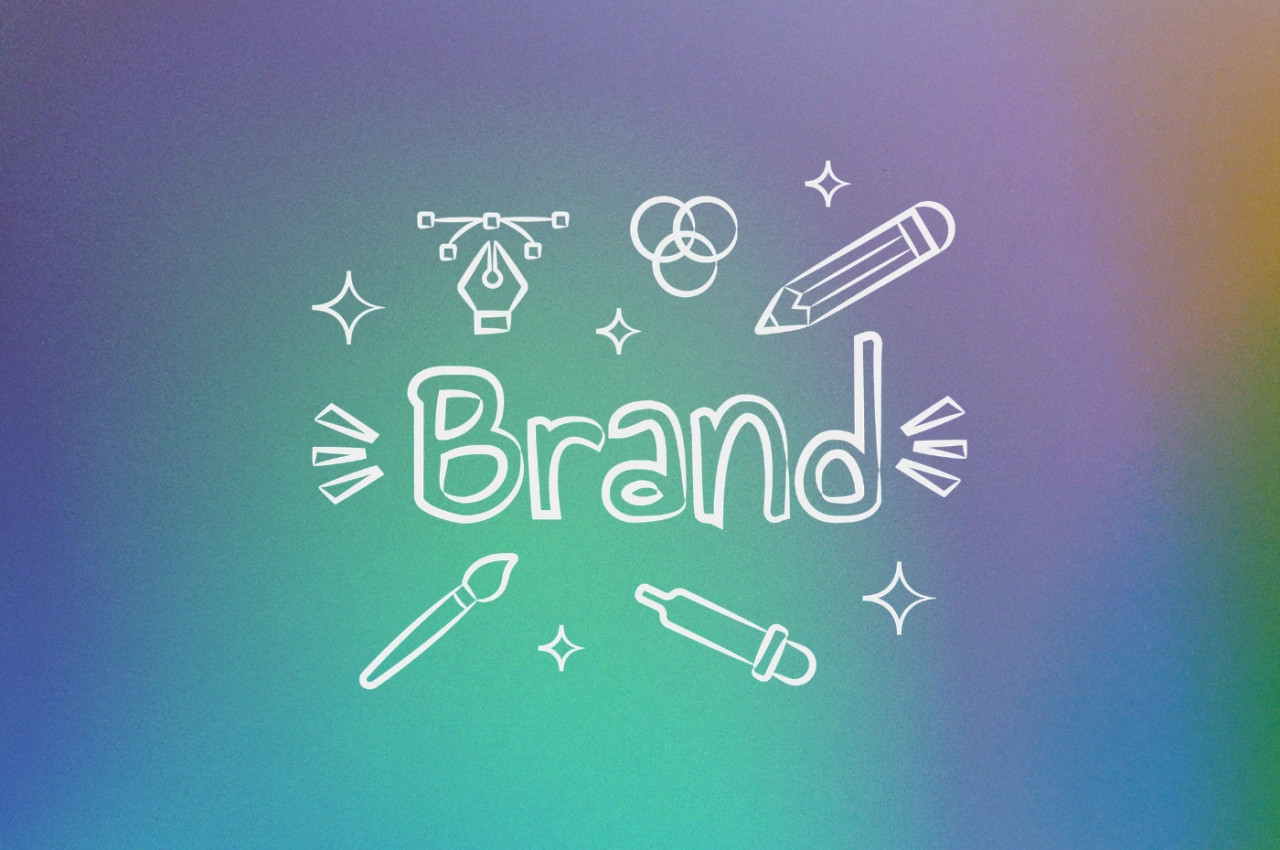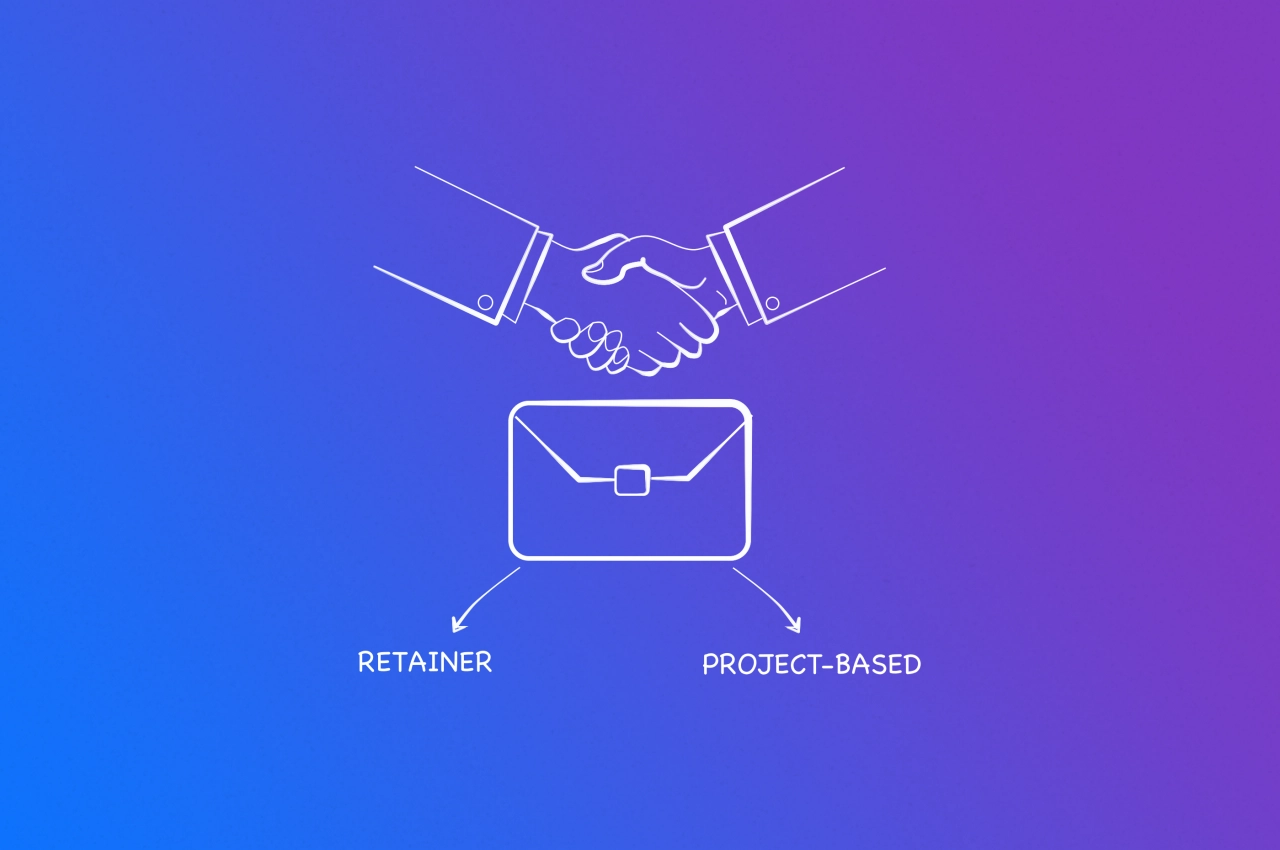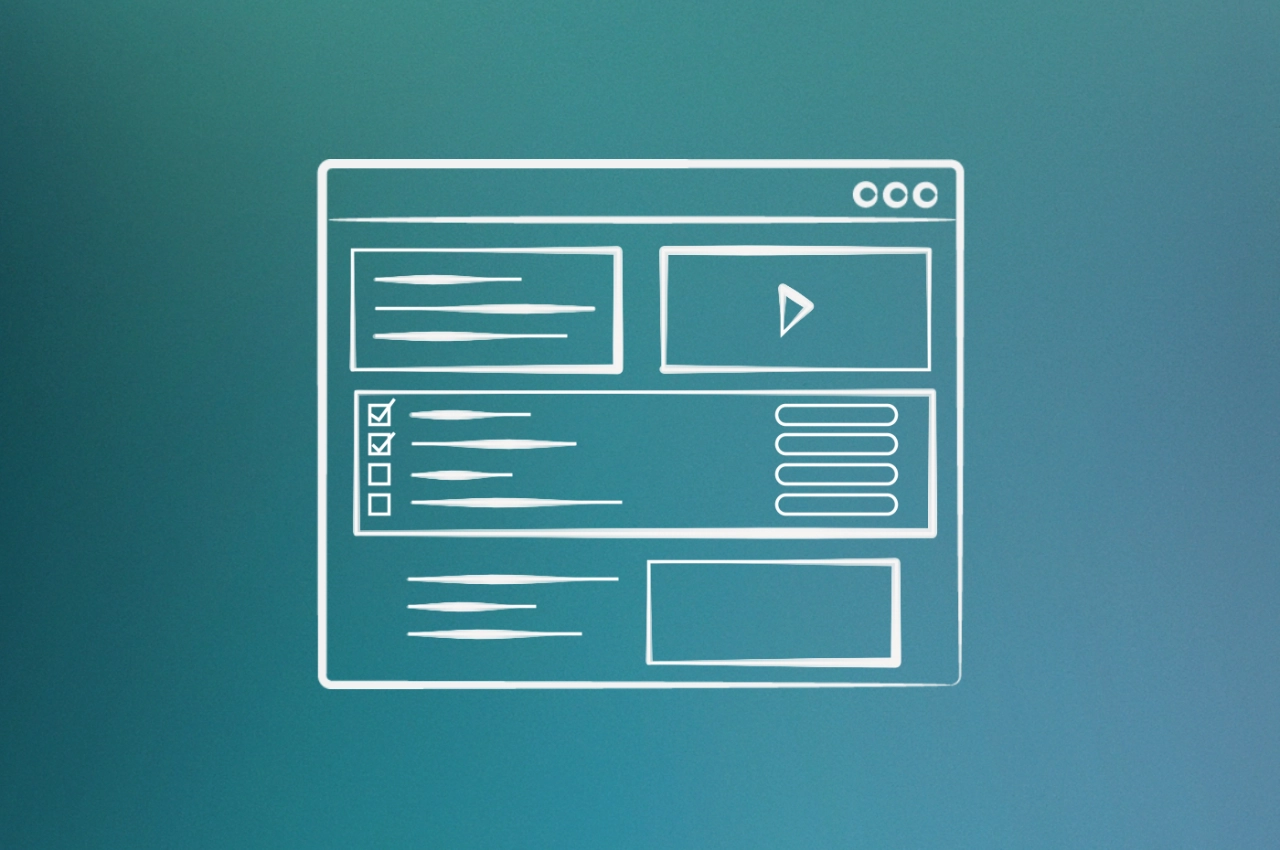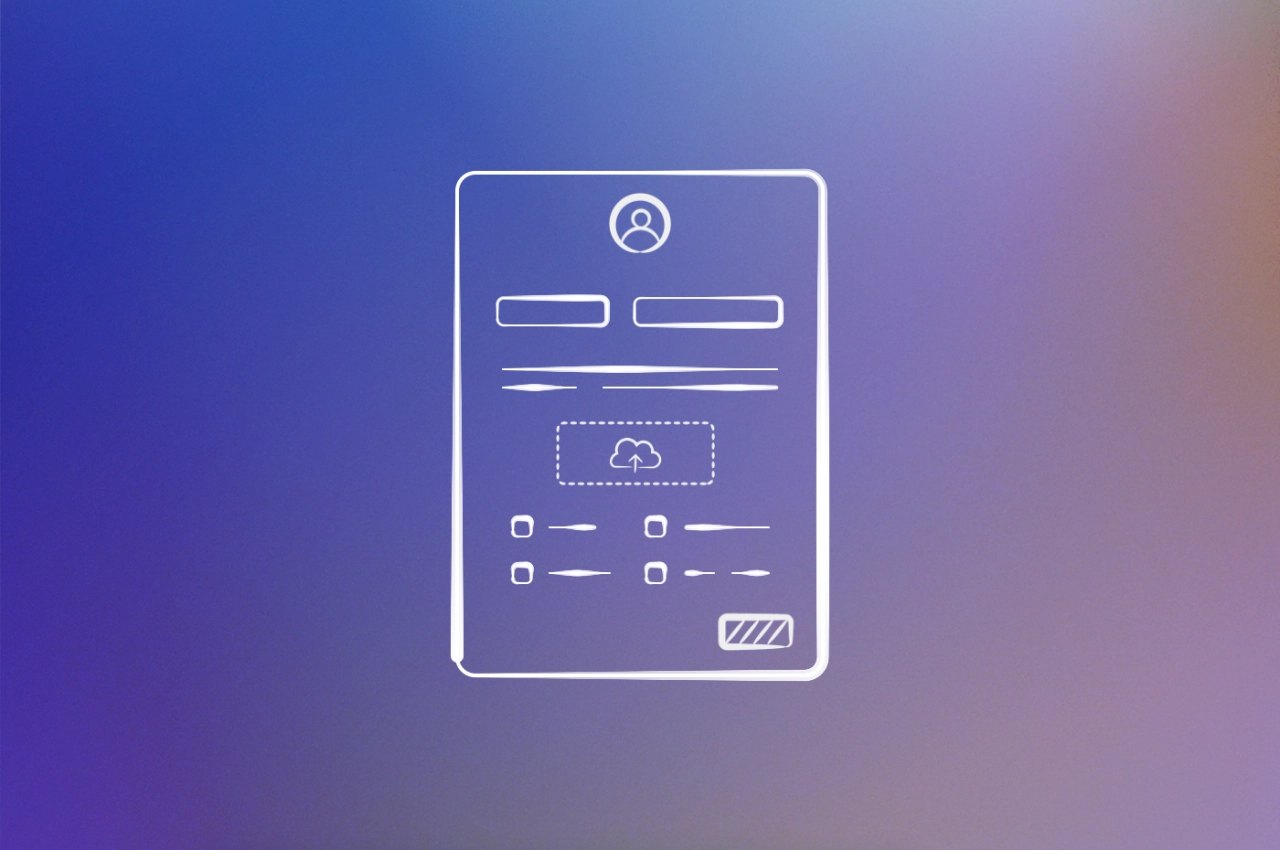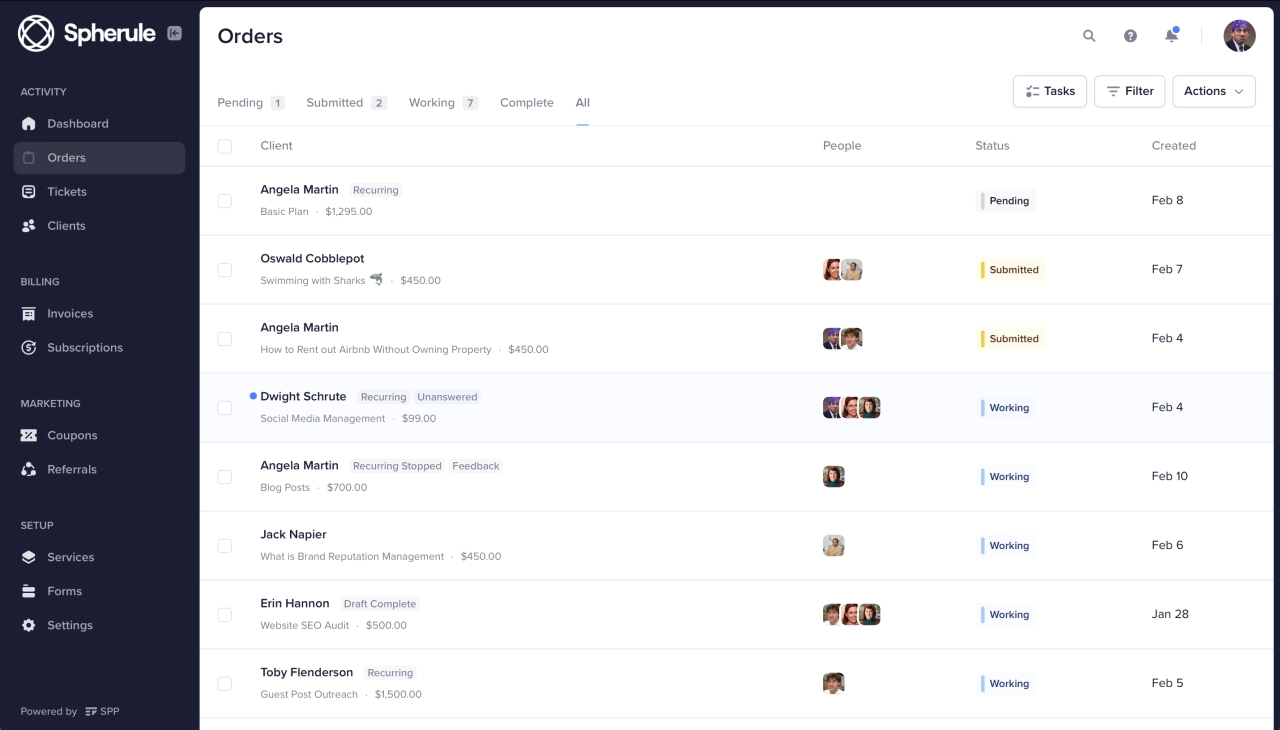- A branding questionnaire is a crucial tool for agencies to gather meaningful client information and develop a compelling brand identity that resonates with customers.
- The benefits of using a branding questionnaire include understanding the client’s vision, identifying their target audience, discovering their unique selling proposition (USP).
- To create an effective branding questionnaire, agencies should start by understanding their clients' businesses, asking the right questions, and using tools like SPP’s form builder.
Iconic productized agencies like Designjoy and Video Husky share a common trait: they are known for their innovative way of offering services. More significantly, they’ve built strong, memorable brand that sets them apart from competitors, foster customer trust, and drive sales.
This emphasizes the crucial role a solid brand identity plays in a company’s success. However, creating one for clients isn’t a stroll in the park. It requires collecting meaningful client information to understand what makes their brand unique. This is where a branding questionnaire comes in: It’s a vital part during client onboarding that helps agencies understand their client’s business, enabling them to develop a compelling brand identity that resonates with customers.
In this article, I’ll cover what a brand discovery questionnaire is, why it’s essential, and how to create one for your agency. I’ll also provide a branding questionnaire template to help you gather essential information from your clients.
Understanding this topic involves several interconnected concepts:
Each of these concepts plays a crucial role in the overall topic.
What is a branding questionnaire?
A branding questionnaire is a list of questions agencies use to gather information about their clients to help develop or refine their brand identity. It encourages clients to think deeply about their business and how they want people to perceive their brand.
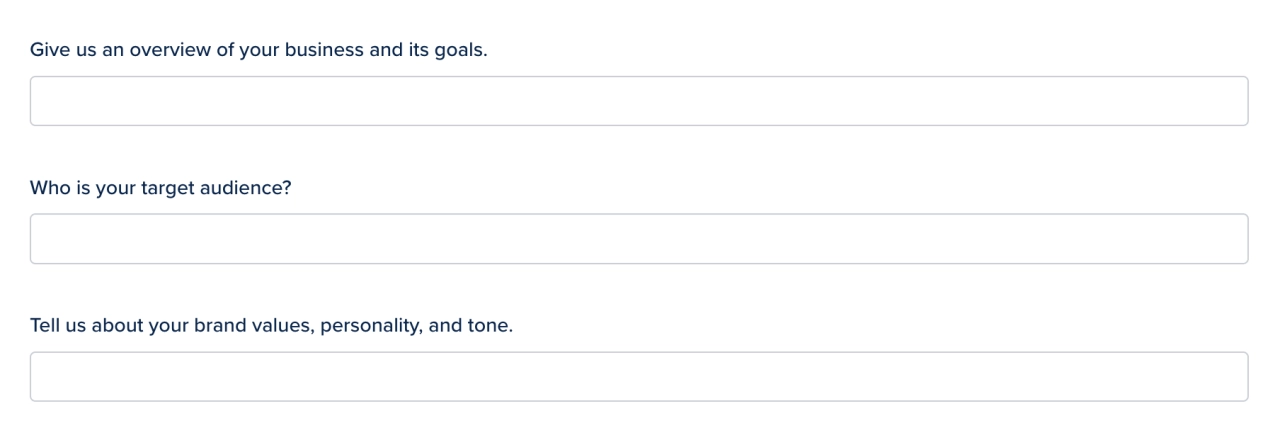
Their responses will guide you in creating messaging, visual elements, and marketing strategies that stand out from competitors.
A typical branding questionnaire contains questions about:
business overview and goals
target audience and ideal client profile
unique selling proposition
brand values, personality, and tone
current branding activity
competitor analysis
visual style
products or services
communication channels and marketing strategies
Reasons to use a brand discovery questionnaire
Building a strong brand identity goes beyond slapping a logo design or catchy slogan on a website and calling it a day. You need deeper insights into your client’s business ethos to know what makes them tick. A brand discovery questionnaire aids this process. Here are six reasons to use one.
1. Understand your client’s vision
Clients often have a clear vision of their brand but need help to articulate it. A brand discovery questionnaire comes in handy here. It prompts them to ponder their needs and preferences. Acquiring this knowledge from the onset allows you to build a brand strategy aligned with their goals.
A solid brand discovery questionnaire is like a cheat code for better client-agency relationships. It gets everyone on the same page fast-digging into goals, audience, tone, and what makes the brand tick. In my experience, it cuts down on endless back-and-forth and keeps projects laser-focused. One time, a client couldn't articulate their vibe until the questionnaire got them to describe their brand as "a cool older sibling who always knows the best coffee spots." Boom-instant clarity. The right questions spark insights and make collaboration smoother, faster, and way more creative.
 Justin Belmont,
Prose
Justin Belmont,
Prose
2. Identify the target audience
The saying “not everyone is your customer” holds true when building a brand identity. In a world full of diverse preferences, needs, and behaviors, appealing to everyone often results in a diluted brand message.
A brand discovery questionnaire helps you identify your ideal customers—people most likely to connect with your brand, buy your products or services, and become loyal advocates. Once you understand their demographics, interests, needs, and struggles, you can tailor the messaging to speak to this group.
3. Discover their unique selling proposition
When businesses offer similar products or services, it can take time to pinpoint what sets them apart. A discovery questionnaire helps uncover your client’s unique value proposition, allowing you to develop a brand identity that stands out.
I once worked with a mid-sized law firm that thought their strengths were no different from their competitors. Through the questionnaire, we learned they had an in-house team of former insurance adjusters who reviewed personal injury cases before they even went to trial. This was a huge advantage, as it gave them deeper insight into how insurance companies operate. They never thought to emphasize it because it was just part of their process. Once we identified this as their USP, we built campaigns that highlighted their expertise in understanding claims from both sides, giving clients confidence in their potential to win cases.
 Mushfiq Sarker,
LaGrande Marketing
Mushfiq Sarker,
LaGrande Marketing
4. Ensures consistency across all touchpoints
Collecting additional information from clients, such as brand visual style, media, and personality, provides clear creative direction, ensuring consistency across all touchpoints and marketing platforms.
5. Saves time
A brand discovery questionnaire streamlines the branding process by gathering all necessary information upfront. This proactive approach prevents endless back-and-forth communication, saving the client and agency valuable time and resources.
A client in the e-commerce sector once filled out our questionnaire and mentioned their seasonal sales patterns in detail. This allowed us to optimize their website’s content and search campaigns well in advance, rather than reacting after the fact. For us we had a smoother workflow and an increase in ROI during their busiest season. The questionnaire is more than just paperwork because it’s how we ensure our technical strategies align with the client’s vision.
 Paul DeMott,
Helium SEO
Paul DeMott,
Helium SEO
6. Have a record on file
Keeping a completed questionnaire ensures both parties are aligned on the project’s deliverables, making it easier to resolve any issues that may arise. It is also a valuable resource for future projects, helping you maintain consistency.
How to create a brand identity questionnaire
Developing a brand identity questionnaire may seem daunting, but it’s quite straightforward. Once you understand your client, ask the right questions, and choose a tool, you’re good to go. Here’s how to create one for your agency.
Understand who the client is
Creating a branding questionnaire without knowing your client is like setting sail without a map—you risk contradicting their vision with the desired outcome. However, understanding your client requires more than just surface-level details. You must delve into their story, motivations, challenges, and aspirations to build a brand identity that genuinely reflects their business.

Here are a few ways to gather the information you need:
Conduct preliminary research: Before diving headfirst into sending a form, research the client’s industry, services, competitors, and market trends. This background knowledge will help you frame your questions more effectively and understand the context of their responses.
Have an initial consultation: An initial discovery call can provide invaluable insights into the client’s business and existing branding activities. This conversation allows you to build rapport, ask follow-up questions, and clarify expectations the questionnaire may not fully address.
Listen to the client’s story: Every brand has a story that makes it stand out. Understanding this narrative will enable you to build a solid brand identity. Ask the client to share their origin story—why they started, what drives them, and how their journey has shaped their brand.
As someone who leads one of the biggest digital marketing agencies in the US, I’d say that a thoughtful brand discovery questionnaire isn’t merely a formal exercise—it’s a golden opportunity to get to know your client, explore possible fit, and articulate their specific pain points. This will help you build trust and position your agency as more of a strategic partner and less of a vendor as you integrate a discovery questionnaire for your sales pipeline. What you want to avoid is to make the relationship purely transactional. In our experience, clients appreciate the time it takes to understand their needs and the tailored recommendations that result from this deep-dive.
 Marc Hardgrove,
The Hoth
Marc Hardgrove,
The Hoth
A deeper knowledge about clients helps you tailor the questionnaire form to address their specific needs, which brings us to the next step.
Ask the right questions
Once you understand your client’s business, you can craft relevant questions that extract meaningful insights about their vision, values, and target audience. However, your questions will depend on their needs and the services you offer.
Here are some examples of relevant questions to ask:
What is your brand’s mission statement?
What core values guide your business?
Who is your ideal customer?
What problems does your product or service solve for them?
Do you have any color schemes, fonts, or brand design elements in mind?
What are their key demographics (age, gender, income, etc.)?
Do you have any existing taglines or slogans?
What tone of voice should your brand use (formal, casual, authoritative)?
What makes your brand unique compared to others in the market?
How do you want to be perceived differently from your competitors?
Choose a tool
With the questions at hand, it’s time to build your branding questionnaire. There are many different tools you could use, but not all of them allow you to be flexible.
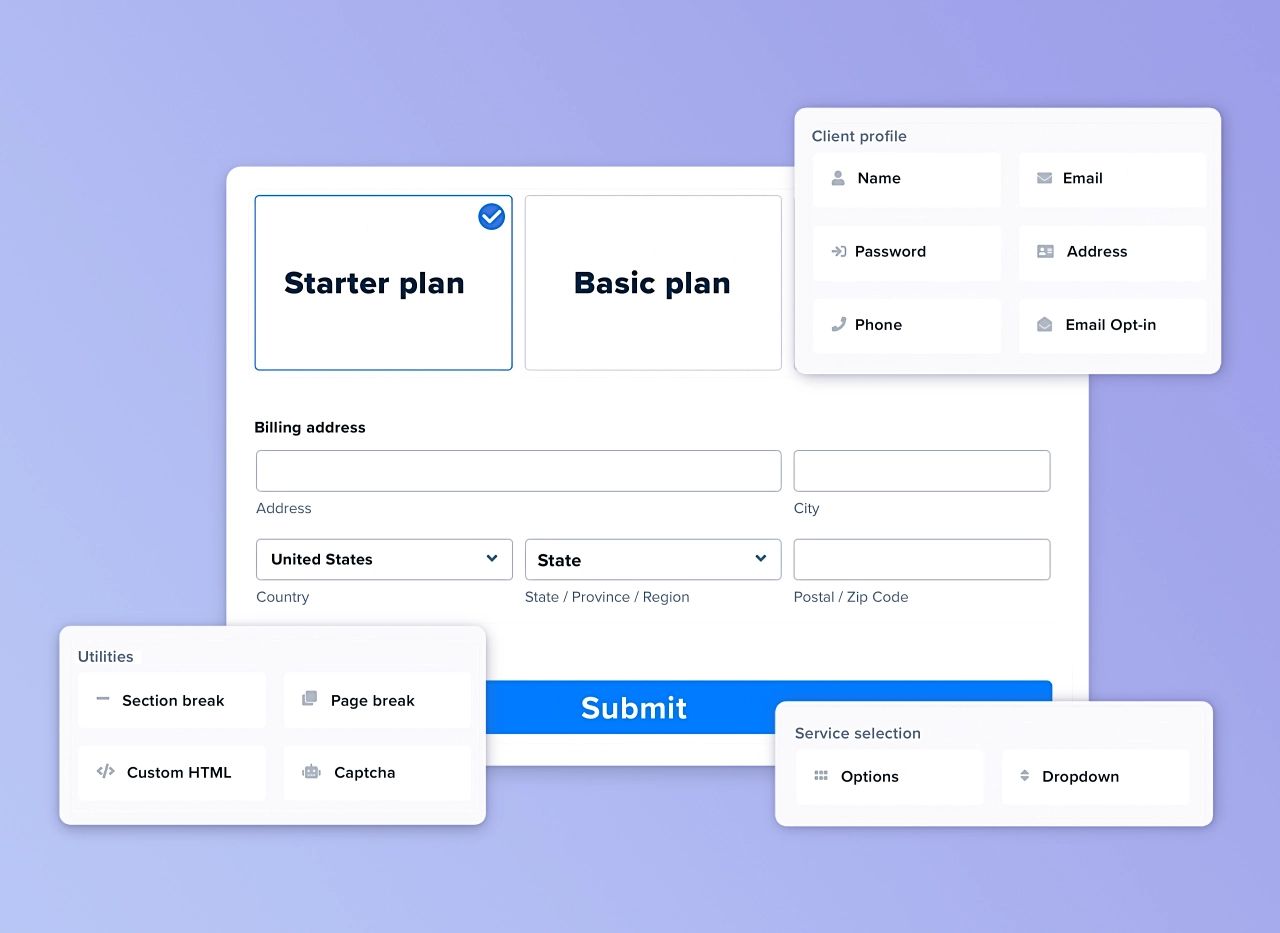
Collect project information, client data, files, and more.
SPP’s onboarding forms make it easy to design a questionnaire for your clients that they can easily fill out. You can set up as many onboarding forms as you need, so the one for the brand can either be part of the client onboarding form, or you can set up a separate one.
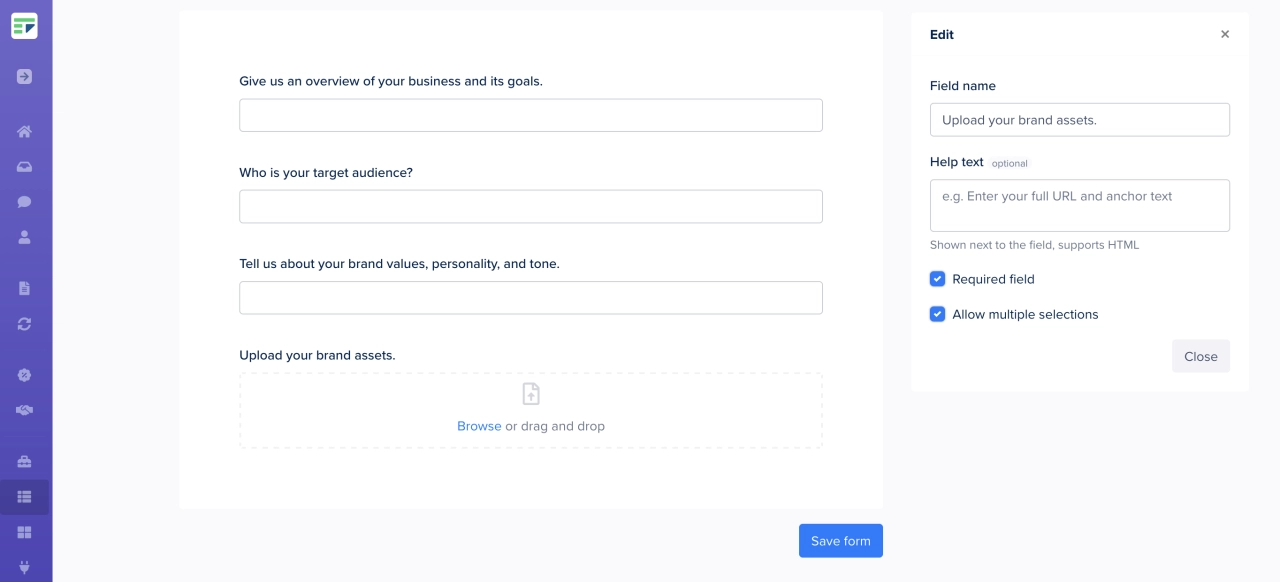
The best thing about our form builder is how flexible it is. You can use any of the existing building blocks to put your form together. You can select between multiple options, such as:
address field
option groups
page breaks
and many more
Once the form has been set up, you can either add it to the onboarding page, set up an automation to send it automatically to your clients in ActiveCampaign, or assign it on a per-client basis manually from the client profile.
Get feedback from clients
Gathering feedback from clients who have completed your questionnaire will help you refine it and improve its clarity. This input can reveal unclear questions or areas needing more detail, allowing you to make adjustments and ensure all necessary information is captured effectively.
Branding questionnaire template (30 questions)
Asking the right branding questions may feel overwhelming, but focusing on key areas makes it much easier. Below are 30 questionnaire templates to guide your client onboarding process.
Brand identity
Ask questions about the client’s business, founders, brand story, team members, vision, and unique selling proposition. This insight provides adequate information to build a brand identity that reflects the essence of the business.
Company
What’s the story behind your brand?
What is your mission statement and core values?
How would you describe your brand personality?
Founder
What motivated you to start the company?
How has your vision influenced the brand’s direction?
What challenges have you overcome in your journey so far?
Team
Who are the key members of your team, and what roles do they play?
How does your team embody the company’s values?
Vision
Where do you see your brand in the next 5–10 years?
Unique selling proposition
What makes your brand unique?
Why should customers choose your business over others?
Ideal customers
Ask these questions to understand your client’s ideal customer profile, where you can find them, and why they buy. This information will help you develop a brand strategy that resonates with the right audience:
Who is your ideal customer?
What are their demographics (age, gender, income, location, job title) and psychographics (desires, goals, interests, challenges)?
Which platforms do they hang out on?
What emotions do you want to evoke in your audience when they come across your brand?
What are common customer objections to buying your services/products?
Services/products
To gain more clarity about your client’s services/products, how they help customers, and their unique features, ask the following questions.
What kind of services/products do you offer?
How do these products/services solve your customers’ pain points?
What are the unique features or benefits of your products/services?
What motivates your customers to purchase your products/services?
Competitors
You can ask the following questions to gain valuable insights into ways to differentiate your client’s business from competitors.
Who are your main competitors?
Can you identify some of their strengths and weaknesses?
How do you track and monitor your competitors?
Goals
Ask questions about your client’s goals and aspirations to better understand their vision and how they measure success. They will align your branding efforts with your client’s aspirations, ensuring the brand identity supports their long-term goals.
What are your short and long-term goals?
How do you see your brand evolving to meet these goals?
What new markets or customer segments are you aiming to reach?
Marketing strategy
What has been your most effective marketing strategy to date?
Which marketing channels do you currently use (social media, email, search engines)?
Which new channels are you interested in exploring?
How do you currently measure the success of your marketing efforts?
Branding questionnaire FAQs
Why does my agency need a brand discovery questionnaire?
A brand discovery questionnaire helps your agency uncover key insights about a client’s vision, target audience, and unique selling proposition. This information allows you to create a tailored brand identity that stands out and resonates with customers.
How do I create a brand identity questionnaire?
Start by understanding your clients, asking the right questions, and using tools like Google Forms or SPP’s white label form builder to create the questionnaire. Then, collect their feedback to refine and improve it.
Understand your client’s brand identity
A well-crafted branding questionnaire is more than just a tool for gathering information. It provides a structured framework to understand your client’s goals, vision, values, target audience, and competitors. With these insights, you can develop a brand identity that resonates with customers, builds trust, enhances perceived value, and increases revenue.
In addition, using a questionnaire tool like the SPP form builder streamlines the information-gathering process, boosts accuracy, increases efficiency and ensures a seamless client experience.

